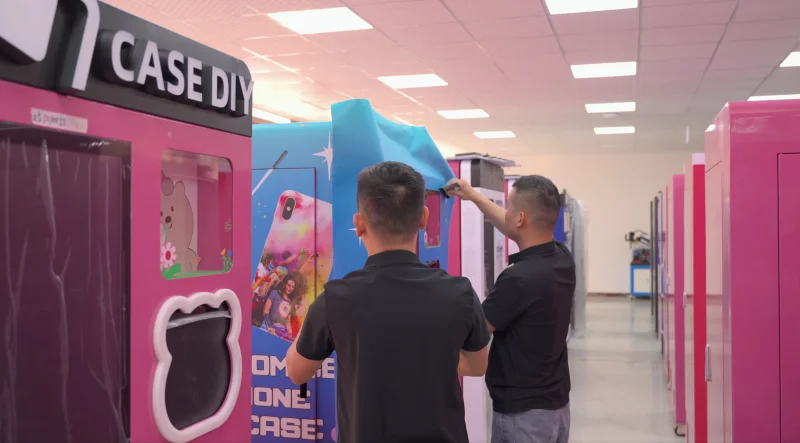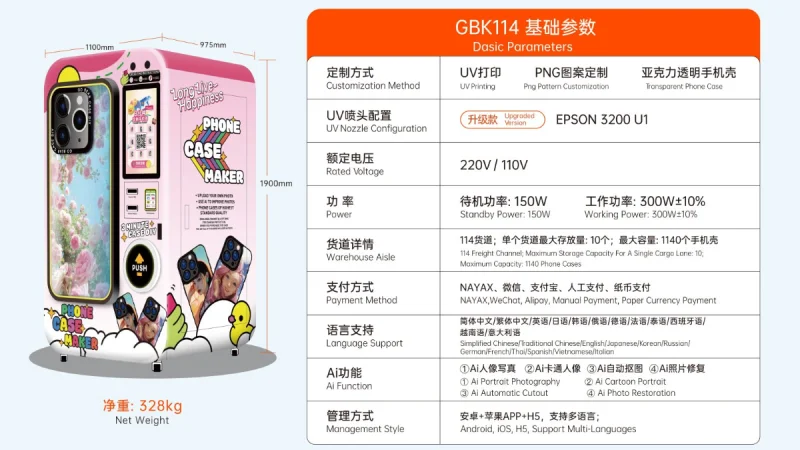Exploring Different Vending Machine Business Models
Explore different vending machine business models and partner with CASE DIY to boost your profits today.
Regarding the "Scan, Edit, and Print" phone case kiosk for Mobile phone communication shops, our strongest recommendation is to avoid a white ink UV printer entirely.
This decision is critical to the success of your in-store customization service. The goal is to provide a seamless, fast, and foolproof experience for both your customers and your staff. White ink directly undermines this goal.
Here's the simple breakdown from your store staff's perspective:
The "white ink dilemma." when a customer scans the code and uploads their design, the software must decide: "Does this design need a white layer underneath?" For designs with transparent backgrounds (PNGs), it does. For designs without, it doesn't.
Most customers are "printing novices." They won't understand this technicality. If they upload a simple JPEG (which doesn't need white ink) but the system applies it anyway, the print might feel thicker. If they upload a PNG and don't get a white layer, the design will vanish on a dark case. This leads to confusion, disappointed customers, and a perception that the technology is "unreliable."
With pre-made white cases and a standard CMYK printer, every single print is the same simple process. No guesswork, no mistakes.
Customers don’t want to think about white layers or transparency. They want a “scan → design → take home” experience. Any glitch, mismatch, or disappearing graphic breaks that illusion and erodes their trust.

The two-step white ink process (print white, cure, then print color) is inherently slow.
To use white ink properly, most systems require:
That extra pass adds time. In practice, it can double or more than double the print time in many phone case vending machines.
A customer using their phone to customize a case is seeking instant gratification. They are excited and want their creation now. Doubling the print time turns excitement into impatience.
A standard CMYK print on a pre-finished white case is a single, swift process, delivering the product in under two minutes and matching the "instant" expectation of a mobile-driven purchase.
White ink contains fine pigment particles (e.g. titanium dioxide) which are heavier and more prone to settling, coagulating, or clogging print heads, tubes, and nozzles—especially during idle periods. Many white-ink printers require regular circulation, agitation, or cleaning to remain functional.
Your staff's worst nightmare is a customer complaining that the kiosk is "out of order." A clogged white ink printer is exactly that. It requires a technical service call, meaning the machine earns $0 and creates customer frustration for days. For a service designed to be always-on, this is an unacceptable risk.
Standard CMYK ink is far more tolerant of intermittent use, ensuring the kiosk is ready when your customers are.

White ink systems require staff to manage ink levels, perform manual cleanings, and understand the nuances of file types.
Your employees are retail professionals, not print technicians. They should be able to assist a customer by saying, "Just scan the code and follow the steps!"-not, "Let me check if the white ink head is clogged."
A CMYK-based system on pre-finished cases empowers your staff to be helpful guides rather than reluctant repairmen.
You've stated the goal is to lock in B2B phone case contracts, with very few transparent PNG designs.
You are paying a massive premium (in hardware, ink, and maintenance) for a "white ink" capability that your core business model does not require. Your B2B clients will provide logos for imprinting on pre-selected case colors. This is the perfect job for a standard CMYK printer. Investing in white ink is like buying a race car to only drive in city traffic-it's overkill, expensive, and finicky.
| Dimension | White Ink System | CMYK + Pre-Finished Case System |
|---|---|---|
| Workflow complexity | High (conditional logic, layered passes) | Low (single consistent path) |
| Print speed | Slower (two passes) | Faster (single pass) |
| Failure / downtime risk | High (clogging, cleaning issues) | Low (stable, robust) |
| Staff training / complexity | High | Low |
| Capital & operating cost | Higher | Lower (simpler modules, standard ink) |
| Business alignment | Overbuilt relative to demand | Well-matched to typical use cases |
| Scalability & replication | Risky | Easier to scale |
It's Customer-Proof: The scan-and-print workflow is seamless. The result is always a high-quality print, regardless of the file the customer uploads.
It's Staff-Proof: Operation and maintenance are minimal. Your team spends time selling, not troubleshooting.
It's Business-Ready: It reliably fulfills the bulk of your B2B orders and walk-in customer jobs without fail, building the strong, dependable reputation you need to lock in those corporate contracts.
By choosing this path, you're not limiting your business; you are focusing it on reliability and profit.

The K114 phone case vending machine delivers instant customization with vivid UV printing, large 1,140-case capacity, and smart AI design tools, all supported by multiple payment options and remote cloud management for effortless operation and high efficiency.
Key Advantages:
A: You can route those rare jobs to an offline white-ink printer (central facility) or have a dedicated white-ink “flagship” location. But don’t burden every kiosk with that complexity.
A: With a good UV CMYK ink system, proper calibration, and selection of lighter-case bases for more extreme colors, you can often deliver acceptable results. For very dark backgrounds, prioritize lighter case options or limit customer selection.
A: Yes—you can design your infrastructure so kiosks can be upgraded. But launch with the simpler, lower-risk path first.
A: Potentially yes. But if your primary vertical is phone cases, optimize for that core. Use specialized devices only where absolutely necessary.
In the scan-edit-print kiosk ecosystem, fancy features—like white-ink capabilities—can quickly become liabilities when viewed through the lens of scale, reliability, and customer satisfaction. What matters is delivering a consistently reliable, fast, low-failure experience. That’s what wins repeat customers, B2B contracts, and brand credibility.
Your best path? Build an Always-Ready CMYK + pre-finished case system. Let white-ink complexity live in back-of-house or specialty zones—not in every kiosk.
Contact our team to get the best solution for your project.
Tell us about your business goals, and our experts will provide a tailored solution and a detailed profitability report. Let's start building your new revenue stream together.